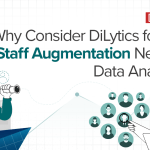Data analytics is a process of analyzing and understanding the data that is collected, stored, and processed. The goal of data analytics is to identify patterns and trends that can be used to improve decision-making processes.
We can use the below 4 Types of Data Analytics methodologies to analyze the different types of data:
1. Descriptive Data Analytics
Descriptive analytics is the most commonly used type of analytics. It helps answer the question of what happened by using attributes, key performance indicators (KPIs) & metrics in reports and dashboards. Using descriptive analytics, the historical data can be aggregated and presented in the form of charts, tables, and graphs for companies to understand what happened to date.
Sales volume can be presented as though it were a line chart indicating growth of sales over the last 4 quarters. Similarly, the operating expenses could be visualized as a pie chart or a bar chart to reveal the distribution of expenses during different periods. These charts and graphs are simple to understand and allow further analysis.
2. Diagnostics Data Analysis
The diagnostic analytics approach requires figuring out the ‘why’. It is about breaking down the available information and identifying the causes behind specific problems, events, and behaviors.
For this reason, diagnostic analytics should be focused on specific problems, meaning that other issues should not be included in the analytical process. This approach allows for better visualizing the data. With the help of diagnostic data analytics, marketing professionals can identify marketing channels that are beneficial to their company or understand audience behavior. Such insights give the companies an edge over the competition.
Individual visualization of each problem is possible through diagnostic data analytics. As an example, if a business wants to know what causes customers to abandon their shopping carts, then they can just analyze that particular issue without interfering with other problems or events.
For instance, when a company is looking for ways to increase the conversion rate, the diagnostic analytics will assist in understanding which tasks and steps make it difficult for shoppers to convert. With this information in hand, they can then focus on fixing or eliminating the obstacles.
It is equally important that a company collects diagnostic data from a variety of sources because it gives a holistic view of a specific problem.
3. Predictive Analytics
Predictive analytics is one of the most well-known and often used types of data analytics. It helps businesses in learning about the future.
It takes the help of the snapshot of the descriptive and diagnostic analytics to identify clusters and exceptions and to predict future trends. It is the most valuable tool for forecasting.
Predictive analytics belongs to advanced analytics types, which brings in many advantages, like sophisticated analysis based on machine or deep learning, and proactive approach that predictions enable.
A predictive model is built during the process of predictive modeling. It is a complex tool that can be used in many industries, including healthcare, marketing, finance, legal, industrial production, etc.
The predictive model focuses on anticipating the future behavior of an object or phenomenon by analyzing past data.
The data used for predictive modeling can be numeric or categorical. Data mining algorithms use it to create models that represent certain real-life patterns.
4. Prescriptive Analytics
Prescriptive analytics is about using predictions to deliver value. It helps in providing the key to the future by prescribing the best course of action among the available alternatives.
Prescriptive analytics is also known as “what-if” analysis. The data model describes the steps required to achieve desired business goals.
Prescriptive analysis is the process of determining the steps to take in order to achieve a particular result or outcome. It helps decision-makers determine actions that are most likely to succeed based on the current business environment.
The analysis is usually spearheaded by data scientists who create algorithms that predict how human behavior will react to future events.
Prescriptive analytics has been in use since the 1980s in the pharmaceutical industry, where it’s used to optimize sales forecasts and sales calls.
It has developed over time and today it’s applied in other industries including marketing, IT, insurance, risk management, and finance. While predictive analytics can tell you what will happen, prescriptive analysis can tell you what should be done to get the desired result.
Conclusion
Today, data science is offering incredible value across most industries. All the four types of data analytics mentioned above continue to contribute to transformation in their own ways!
Get in touch with us to explore how DiLytics can help your company leverage the advantage of Data Analytics in an efficient way.





